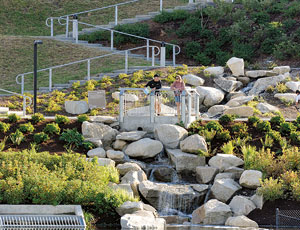Veteran academic Frederick R. Steiner is a consensus builder. For the Sustainable Sites Initiative, he brought together myriad, diverse interests in all areas of design and construction to develop the world’s first green rating system devoted to landscapes. The dean of the school of architecture at the University of Texas at Austin is credited with catalyzing, inspiring and leading the multidisciplinary team that produced the benchmarks and guidelines for the $2-million Sustainable Sites Initiative, published in November. SITES, a voluntary rating system, is designed to encourage development, design, construction and operation of eco-friendly landscapes. The guidelines are fast becoming a standard for sustainability.


“Fritz has been a tremendous asset and a wise adviser in guiding the development of SITES,” says Deb Guenther, a principal at Mithun and a member of the SITES steering committee.
Steiner demurs, saying SITES was “a quintessential team effort.” His initial role was that of matchmaker, bringing together SITES’ first two developers: the American Society of Landscape Architects (ASLA) and the Lady Bird Johnson Wildflower Center (LBJWC), which is part of the University of Texas. Steiner then became a member of the SITES executive and steering committees. He also is on the SITES soils technical committee.
Steiner’s and SITES’ central message is that any landscape—whether the site of a large subdivision, a shopping mall, a park, an abandoned rail yard, a highway, an industrial site or a single home—holds the potential to both improve and regenerate natural benefits and services provided by ecosystems in their undeveloped state. SITES is very much in line with Steiner’s vision to provide clear and rigorous criteria for sustainable landscape design, construction, operations and maintenance, says Steven Windhager, LBJWC’s director of landscape restoration and SITES.
Having overcome the big hurdle—reaching consensus on the benchmarks and publishing them—SITES is currently collecting pilot projects, which will be used as a “reality check” for the rating system, says Steiner.
The deadline to submit is Feb. 15. SITES is seeking an assortment of landscapes: large and small, public and private, those with buildings and those without. The chosen pilots will also represent geographic diversity. “We want to make sure not every project comes from Seattle and Portland,” says Steiner.
Work on SITES, which ramped up in 2006, gobbled up as many as six to eight hours of Steiner’s time each week. But that didn’t stop him from being productive in other ways. Steiner not only inspires practitioners and students, he writes. He recently handed in the manuscript for his next book, “Design for a Vulnerable Planet,” to be published by UT Press in spring 2011. He already has another book project lined up. The subject is one he is particularly passionate about: ecological urban design.
Steiner says his most successful book is “The Living Landscape,” first published in 1990 by McGraw-Hill Cos. However, Steiner is not a landscape architect, though he is a fellow of ASLA. And he is not an architect, though he is a dean of architecture. He has a Ph.D. in city and regional planning, with degrees in community planning and graphic design.
Steiner is credited with inspirational leadership and consensus-building that produced the first rating system for sustainable landscapes.
“Fritz is one of those rare individuals who is able to encompass both the needs of humans and the rest of the natural world in planning and landscape architecture,” says Windhager.
Steiner has served as a city planning commissioner. He has worked with local, state and federal agencies on environmental plans, and he has authored or co-authored about a dozen books. With all that he has done, he cites raising two children, who now are in their twenties, as his best accomplishment. “It’s not as abstract as writing a book,” he says.


Post a comment to this article
Report Abusive Comment